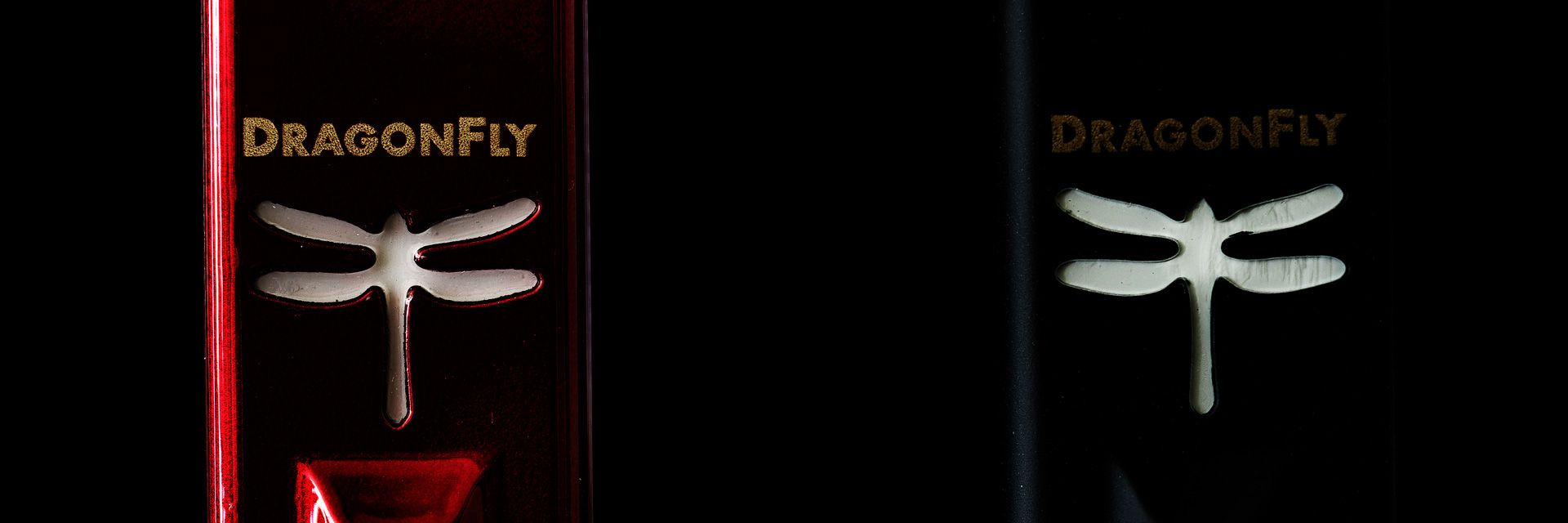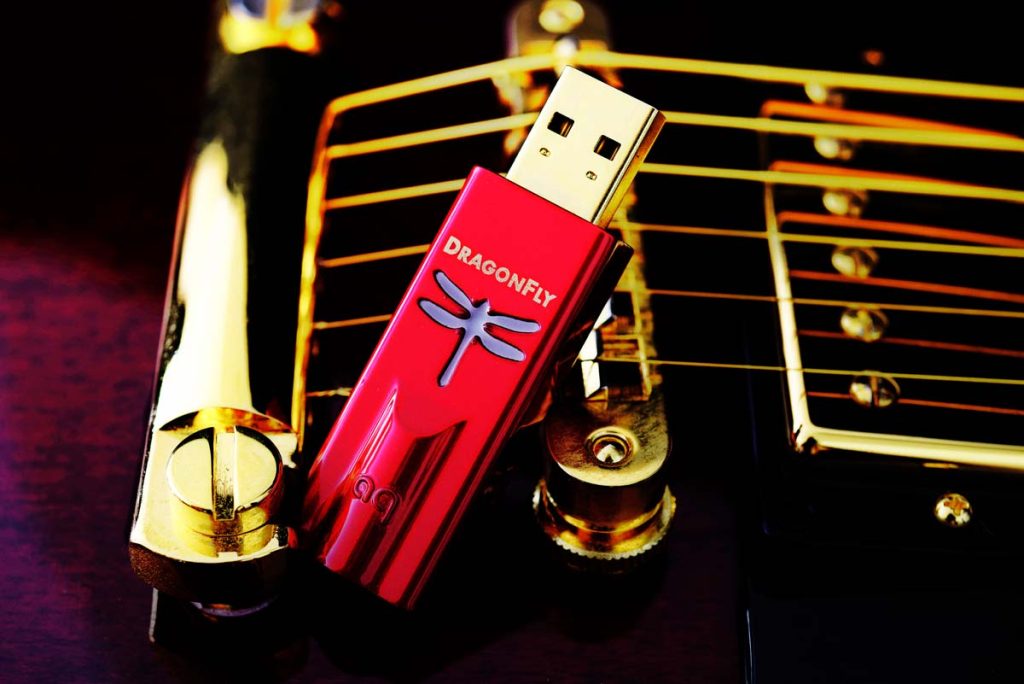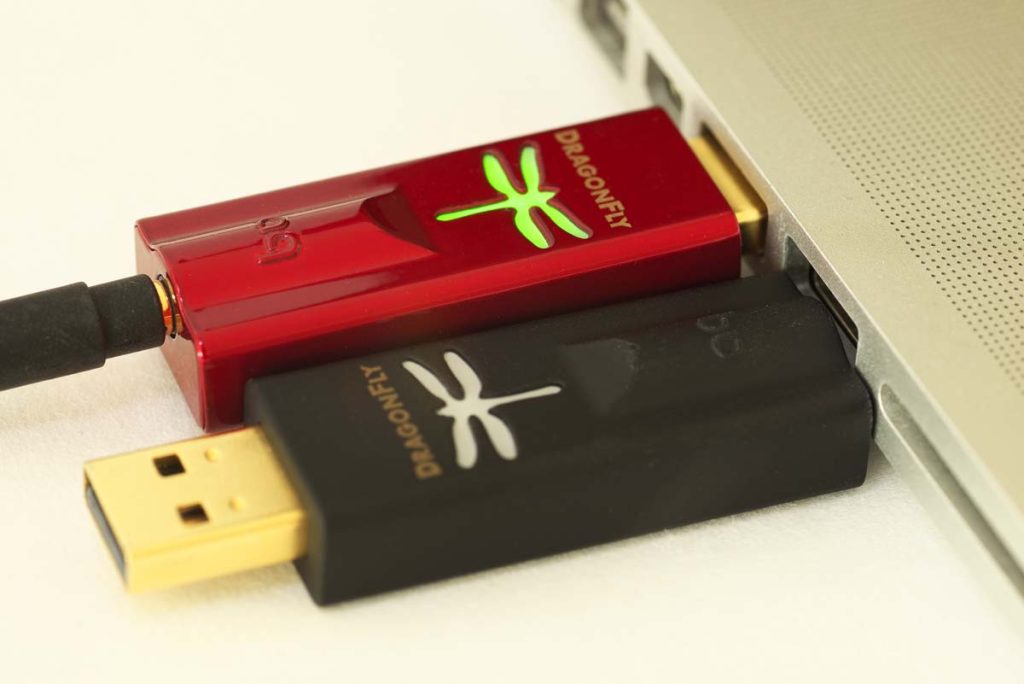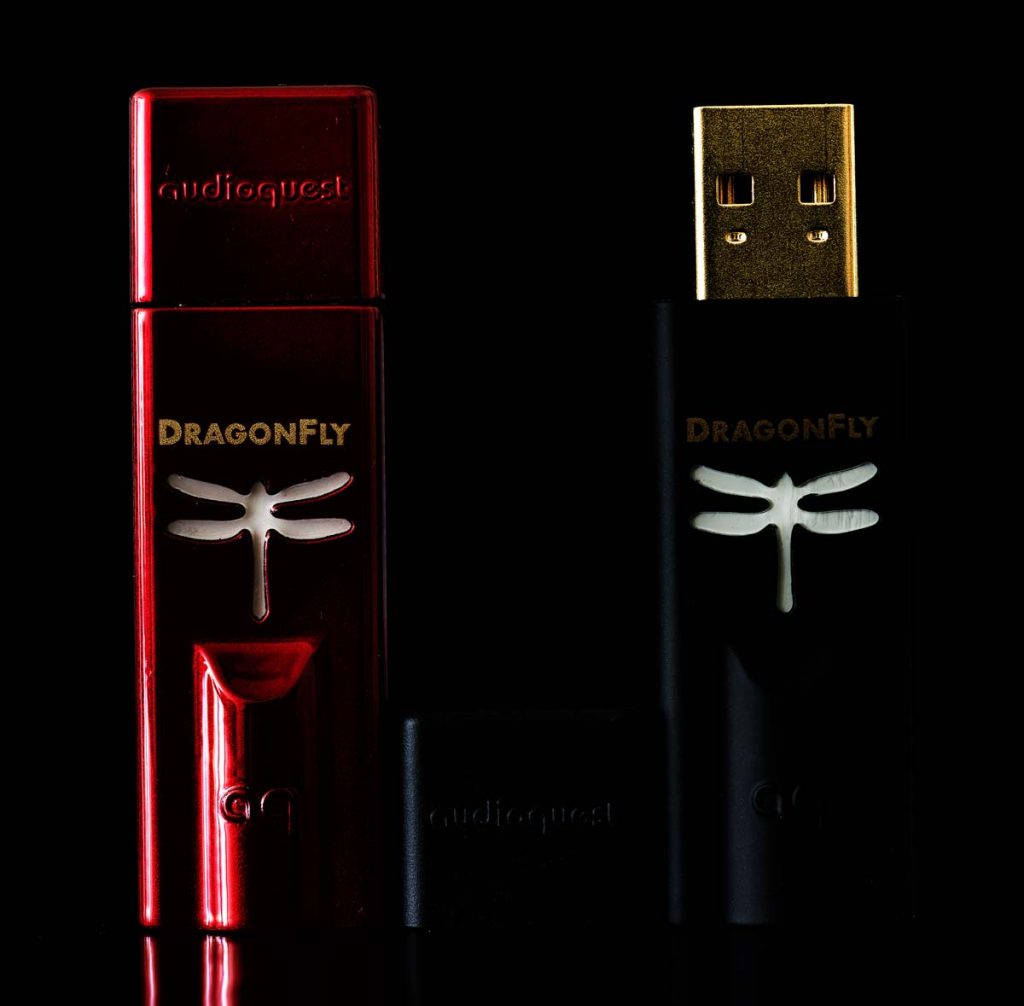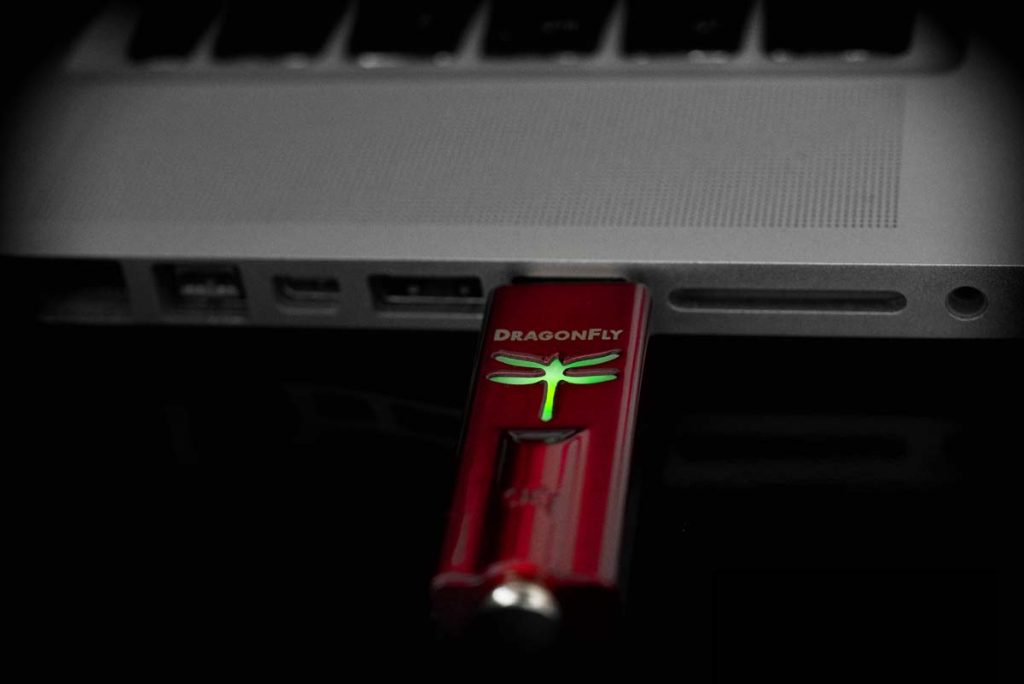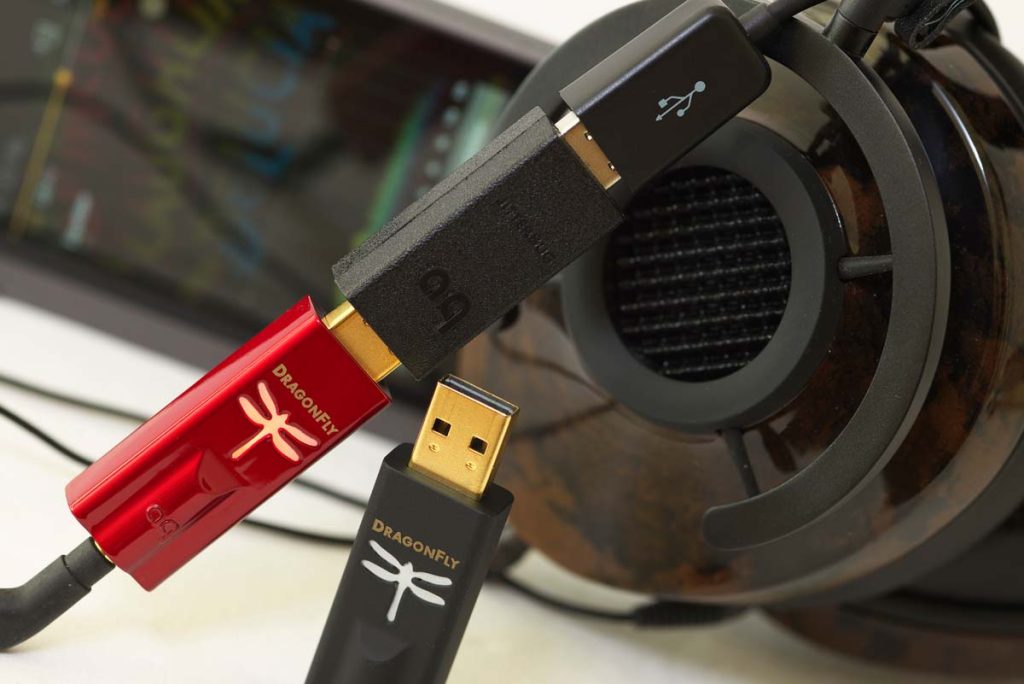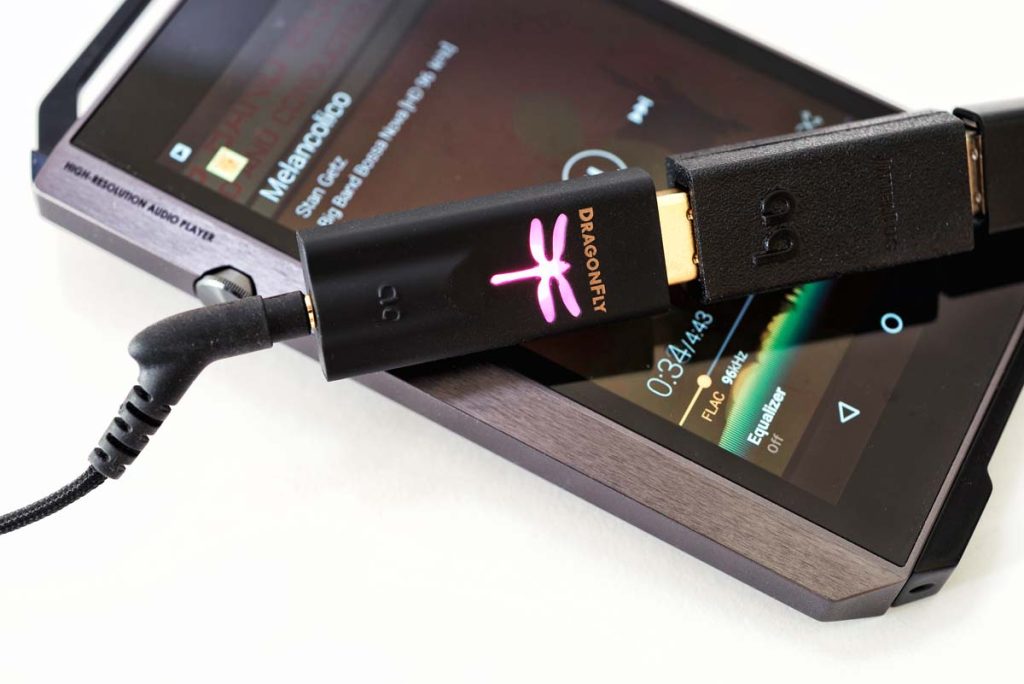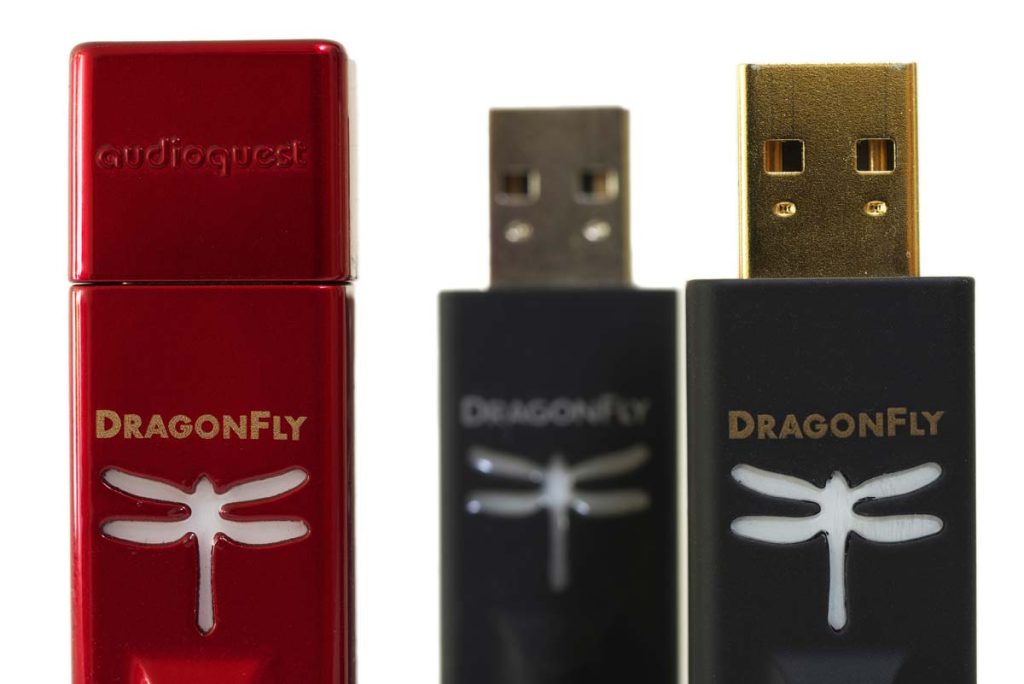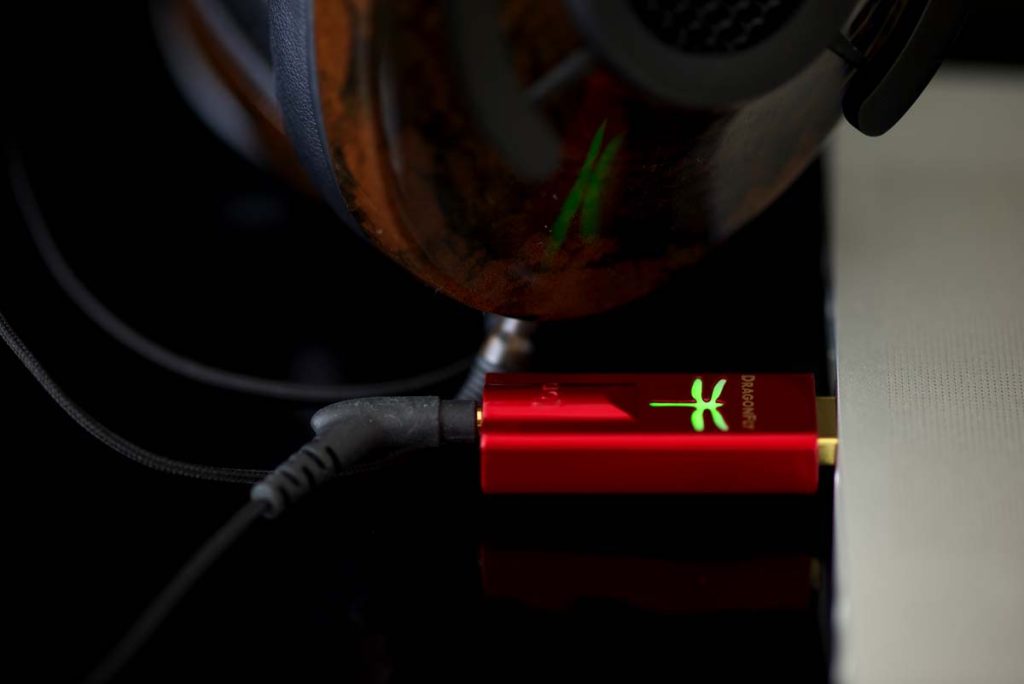Oh, AudioQuest discontinued production of their famous USB digital-to-analog converter. Ah, but they’ve given high-flying audiophiles two sleek successors with DragonFly Black and DragonFly Red.
When AudioQuest introduced the hi-fi community to DragonFly V1.2 in 2012, it was a minor sensation for the American company: Never before had engineers dared infuse a DAC with integrated headphone amp and a USB stick format with this much sound expertise. The plug-in DragonFly was an easy sound upgrade for every PC; music enthusiasts could simply sit back and take off into hi-fi heaven. The last four years have seen AudioQuest developers still hard at work, and now the company has introduced not one but two successor models to the original DragonFly, the DragonFly Black and DragonFly Red. With their matt black and metallic red exteriors, these new models are difficult to distinguish from their predecessor. But packed inside, the new DragonFly’s interiors, so critical to sound, have been completely overhauled, and now both USB DACs can be operated on smartphones and tablets, too. The easy-to-pack feast for the ears for on-the-go has also become more affordable: While the original DragonFly set your wallet back by €250, the DragonFly Black is now offered at just under €100 and DragonFly Red at about €200.
AudioQuest takes its work seriously and consistently uses premium components that are assembled following the rules of high-frequency engineering: Even the DragonFly V1.2 was equipped with a premium converter chip, the ESS Sabre 24-bit chip 9023. For the new models, developers engaged in some powerful chip tuning and used current ESS Sabre 32-bit chips: The less expensive black version features the ESS 9010, which can translate zeros and ones into perceptibly detailed sound thanks to improved converter linearity and a minimum-phase digital filter. For the red version, digital-to-analog conversion is handled by the ESS 9016, which provides even greater precision and ensures more natural details with maximum dynamics and minimum noise.
There are also key differences when it comes to the headphone amplifier: While the DragonFly Black inherited the headphone amp with analog volume control from its predecessor, the DragonFly Red has an ESS headphone amp that is integrated in the DAC chip 9016. It’s the latest ESS-HPA and features digital volume control. Thanks to bit-perfect volume control — from the 32-bit converter architecture with a maximum dynamic of 192 dB — dynamics are not audibly restricted.
And even though experts still don’t agree whether digital volume control is actually better than analog, it does have undeniable benefits. When diligently implemented, digital volume control will prevent balance inaccuracies and crosstalk. The DragonFlys don’t have their own volume control, however. Both the analog volume control of the Black and the digital of the Red is operated and, to a certain degree, remote controlled by the host device — whether a PC, smartphone or tablet.
Streamlined wings
Apropos smartphone or tablet: With the 2002 Texas Instruments TAS1020B, the original Dragonfly featured one of the first good USB controller chips for audio applications. But the microcontroller, powerful even according to today’s standards, has one disadvantage: Its insatiable appetite for power drains the battery of the mobile device in nothing flat. To solve this, AudioQuest has put a microcontroller from Arizona Microchip Technology in the two new models. This is supposed to reduce power consumption by a remarkable 77 percent — so using it with a smartphone or tablet is no problem at all. In addition, the chip bearing the enigmatic name PIC32MX can be upgraded using software installed on a PC — a real advantage. The application to do this, which will be available as a free download, is still being prepared.
The DragonFly Black has an output of just a 1.2 volts (1.8 for its predecessor), but AudioQuest maintains that its efficiency is more than adequate for powering all preamp circuits as well as low impedance, or loud to medium-loud, headphones. And the new DragonFly actually does work more efficiently than the old one — once again thanks to the improved DAC chip and the new microcontroller. The metallic red version still outdoes both of the black models though: With its higher output of 2.1 volts, it’s a real powerhouse, which means it works well with the high-impedance headphones.
Even though the ESS converter chips of the new black and red models can handle PCM signals with a maximum resolution of 32-bit/284-kHz and DSD files up to 11.2 MHz, AudioQuest developers decided to implement a sampling rate limit of 96 kHz. This enables the DragonFlys to work with generic drivers without having to download and install proprietary ones. The dragonfly icon displays the current sampling rate: It glows green at 44.1 kilohertz, blue at 48, orange at 88.2 and magenta at 96 – the models really reflect a commitment to straightforward operation for everyone using a practical approach with a minimal amount of information. As a result, users don’t even need to consult the manual to dive in and start enjoying these little converters.
Great fun factor
These cute converters have a truly great fun factor. In its black and red models, AudioQuest has not only held true to the notion of “plug in and take off,” the company has gone far to demonstrate its conviction. On their first test runs on the MacBook Pro with audiophile software player Audirvana Plus, both DragonFlys performed convincingly right from the start. Controlling the volume from the virtual Audirvana cockpit worked like a dream with the new models (unlike the predecessor). Volume control now remains outside the operating system that tinkers with the files themselves. A PC-savvy audiophile can take a deep breath and let his or her perked ears focus on the sound of the DragonFly. Even the extraordinarily wellpriced Black makes a strong impression and delivers a highly detailed conversion with outstanding dynamics. Pink Floyd’s Masterpiece Wish You Were Here in FLAC format with 24-bit/96-kHz resolution, initially relished on the AKG K702 Studio, thrills with the rampant synthesizer sounds of “Shine On You Crazy Diamond.” When Dave Gilmore presents his extraordinary electric guitar melodies, it’s plain to hear: The DragonFly Black provides an astonishing amount of sound tuning for the money. Even with the direct line to my SPL monitoring controller with a fixed line out level (Audirvana setting 0 dB) for listening with active monitors from ME Geithain, the test is persuasive and Pink Floyd transfixes me for another 45 minutes before I can bring myself to move on to the next test. So, everything’s tops.
Everything’s tops? At least until it comes time to test a DragonFly Red. After all: The more expensive DragonFly is definitely a step up. In a direct comparison, its sound is considerably more fine-grained and works without the minimal presence boosting of the Black. While extremely detailed, the DragonFly Red sounds pleasantly full in the highs, which gives Dave Gilmore’s Stratocaster its so characteristic melodiousness. The intricate piano and powerfully resolute chorus arrangement on the ballad “Here’s That Rainy Day“ (The Oscar Peterson Trio & The Singers Unlimited: In Tune) sound grander, more full — just like the fond and precious balsam for the ears I know.
The original DragonFly, which sounds somewhat full and less selective, is effortlessly surpassed by this new golden red model. AudioQuest’s mini-converter even plays to within earshot of the high-end converter Mytek Digital Stereo192-DSD DAC, whose outstanding signal fidelity and precision it doesn’t quite reach on, for instance, the basses, but come on: We’d also have to talk about the Mytek’s fivefold price! But the shiny metallic DragonFly Red with the much smaller price tag is eminently suited for a mobile device: With the USB on-the-go adapter and AudioQuest JitterBug as a sound-enhancing connecting link to the smartphone, it plays with such power that even high-impedance or low-efficiency headphones can transform sound from pocket phones — and how! The DragonFly Black may be somewhat less powerful, but it is also smartphone compatible. This means that those in search of a truly great and lower-cost USB converter/headphone amp will find what they are looking for. And those who harbor even greater audiophile demands will really take off with the DragonFly Red, a true high-flyer!
Accompanying Equipment
Computer: Apple MacBook Pro | Player software: Audirvana Plus | Headphones: AKG K702 Studio, AudioQuest NightHawk | DAC: Mytek Digital Stereo192-DSD DAC | Controller: SPL MTC 2381 | Active monitors: Geithain RL 906 | Accessories: Vovox Sonorus, AudioQuest Evergreen, AudioQuest JitterBug
USB digital-to-analog converter
AudioQuest DragonFly Black and DragonFly Red
Digital inputs: 1 x USB | Operating systems: Windows 7, 8, 10; Mac OS-X; Apple iOs 5 or newer; Android | Compatible formats: PCM up to 24 bit, sampling rates 44.1, 48, 88.2, 96 kHz | Analog outputs: 1 x 3.5 mm jack | Output: 1.2 V (Black) / 2.1 V (Red) | Volume control: analog (Black) / 64-stage digital (Red) | Special features: AMT PIC32MX microcontroller, ESS Sabre 32-bit chips: ESS 9010 (Black) / ESS 9016 (Red) | Finish: metal casing with gold plug, matt black rubberized (Black); coated red metallic (Red) | Dimensions (B/H/T): 19/12/62 mm | Warranty: Two years | Price: €99 (Black) / €199 (Red)
AudioQuest, The Quest Group B.V.
Hoge Bergen 10
4704 RH Roosendaal
Netherlands
Phone +31 165 541404

